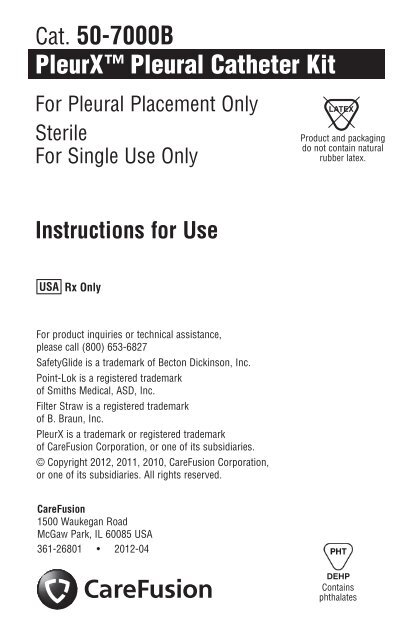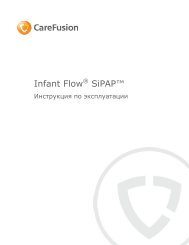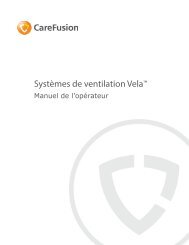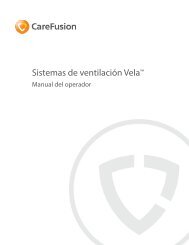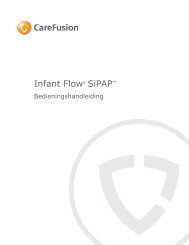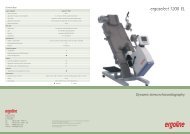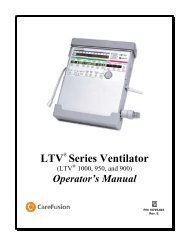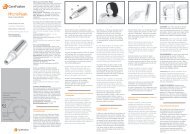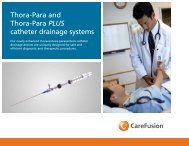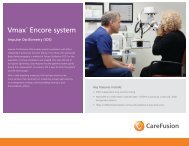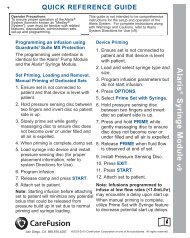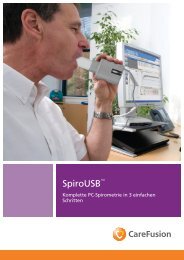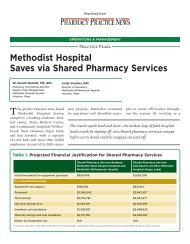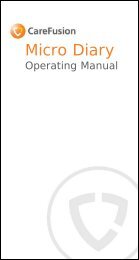PleurX™ Pleural Catheter Kit Cat. 50-7000B - CareFusion
PleurX™ Pleural Catheter Kit Cat. 50-7000B - CareFusion
PleurX™ Pleural Catheter Kit Cat. 50-7000B - CareFusion
Create successful ePaper yourself
Turn your PDF publications into a flip-book with our unique Google optimized e-Paper software.
<strong>Cat</strong>. <strong>50</strong>-<strong>7000B</strong><br />
PleurX <strong>Pleural</strong> <strong><strong>Cat</strong>heter</strong> <strong>Kit</strong><br />
For <strong>Pleural</strong> Placement Only<br />
Sterile<br />
For Single Use Only<br />
Instructions for Use<br />
USA<br />
Rx Only<br />
For product inquiries or technical assistance,<br />
please call (800) 653-6827<br />
SafetyGlide is a trademark of Becton Dickinson, Inc.<br />
Point-Lok is a registered trademark<br />
of Smiths Medical, ASD, Inc.<br />
Filter Straw is a registered trademark<br />
of B. Braun, Inc.<br />
PleurX is a trademark or registered trademark<br />
of <strong>CareFusion</strong> Corporation, or one of its subsidiaries.<br />
© Copyright 2012, 2011, 2010, <strong>CareFusion</strong> Corporation,<br />
or one of its subsidiaries. All rights reserved.<br />
<strong>CareFusion</strong><br />
1<strong>50</strong>0 Waukegan Road<br />
McGaw Park, IL 60085 USA<br />
361-26801 • 2012-04<br />
LATEX<br />
Product and packaging<br />
do not contain natural<br />
rubber latex.<br />
DEHP<br />
Contains<br />
phthalates
Diagram
(4)<br />
(5)<br />
(6)<br />
(7)<br />
“CLICK”<br />
(8)<br />
(A)<br />
(B)<br />
(C)<br />
Diagram<br />
“CLICK”<br />
(9)<br />
(11)<br />
(12)<br />
(13)<br />
“CLICK”<br />
(14)<br />
(10)
Instructions for Use<br />
<strong>Kit</strong> Contents<br />
Preparation Components<br />
2 ChloraPrep 10.5 ml Applicators<br />
with Hi-Lite Orange Tint<br />
1 Fenestrated Drape<br />
1 Filter Straw<br />
3 Lidocaine HCl 1%, 5 ml Ampules<br />
1 SafetyGlide Needle, 22 Ga. x 1 ½” (3.8 cm)<br />
1 SafetyGlide Needle, 25 Ga. x 1” (2.5 cm)<br />
1 CSR Wrap<br />
Placement Components<br />
1 PleurX <strong>Pleural</strong> <strong><strong>Cat</strong>heter</strong>, 15.5 Fr.<br />
1 Safety Scalpel<br />
1 Guidewire Introducer with Needle<br />
2 Syringes, 10 ml<br />
1 Point Lok Sharps Safety Device<br />
1 J-tip Guidewire<br />
1 Forceps<br />
1 Dilator, 8 Fr.<br />
1 Dilator, 12 Fr.<br />
1 Peel-Away Introducer, 16 Fr.<br />
1 Tunneler<br />
Closing Components<br />
1 Tweezer<br />
1 Silk Suture, 2-0 Straight Needle<br />
1 Absorbable Suture, 3-0 Curved Needle<br />
Drainage Components<br />
1 Drainage Line with Lockable Access Tip<br />
1 Needle, 17 Ga. x 1” (2.5 cm)<br />
1 5-in-1 Drainage Line Adapter<br />
1 Alcohol Pad<br />
1 Valve Cap<br />
Dressing Components<br />
6 Gauze Pads, 4” x 4” (10.2 cm x 10.2 cm)<br />
1 Foam <strong><strong>Cat</strong>heter</strong> Pad<br />
1 Self-Adhesive Dressing<br />
PleurX <strong>Pleural</strong> <strong><strong>Cat</strong>heter</strong> Description<br />
The PleurX <strong>Pleural</strong> <strong><strong>Cat</strong>heter</strong> consists of a fenestrated<br />
silicone catheter with a valve mechanism and a<br />
polyester cuff. A barium sulfate stripe runs the entire<br />
length of the catheter. The valve is designed to<br />
prevent the passage of air or fluid in either direction<br />
unless it is accessed with the specifically matched<br />
drainage line or vacuum bottles provided by<br />
<strong>CareFusion</strong>.<br />
1<br />
2.225 cm<br />
Fenestrations<br />
25.5 cm<br />
Lockable Access Tip<br />
PleurX <strong>Pleural</strong> <strong><strong>Cat</strong>heter</strong><br />
<strong><strong>Cat</strong>heter</strong>: 66.0 cm<br />
Polyester<br />
Cuff Valve<br />
12.5 cm 28 cm<br />
Internal Portion External Portion<br />
(1)<br />
PleurX Lockable Drainage Line<br />
Drainage Line: 61 cm<br />
(2)<br />
Pinch Clamp<br />
Luer Lock<br />
Indications<br />
The PleurX <strong>Pleural</strong> <strong><strong>Cat</strong>heter</strong> <strong>Kit</strong> (<strong>Cat</strong>. <strong>50</strong>-<strong>7000B</strong>) and<br />
the PleurX Drainage <strong>Kit</strong>s (REF <strong>50</strong>-7<strong>50</strong>0 series and<br />
REF <strong>50</strong>-7510 series) are indicated for:<br />
• Intermittent, long term drainage of symptomatic,<br />
recurrent, pleural effusion, including malignant<br />
pleural effusion and other recurrent effusions that<br />
do not respond to medical management of the<br />
underlying disease<br />
The devices are indicated for:<br />
1) the palliation of dyspnea due to pleural<br />
effusion<br />
2) providing pleurodesis (resolution of the pleural<br />
effusion)<br />
Contraindications<br />
Use of the PleurX <strong>Pleural</strong> <strong><strong>Cat</strong>heter</strong> <strong>Kit</strong> and the PleurX<br />
Drainage <strong>Kit</strong> is contraindicated in the following<br />
situations:<br />
1. When there is a shift > 2 cm in the mediastinum<br />
towards the ipsilateral side of the effusion.<br />
2. When the pleural cavity is multi-loculated, and the<br />
drainage of a single loculation would not be<br />
expected to provide relief of dyspnea.<br />
3. When there is a coagulopathy.<br />
4. When the pleural cavity is infected.<br />
5. When the effusion is known to be chylous.
Warnings<br />
Do not put anything except the access tip of the<br />
lockable drainage line or PleurX Vacuum Bottles into<br />
the PleurX <strong><strong>Cat</strong>heter</strong> valve since this could damage<br />
the valve. A damaged valve may allow air into the<br />
body or let fluid leak out through the valve when not<br />
draining.<br />
Cautions<br />
For single use only. Re-use may result in a nonfunctional<br />
product or contribute to cross<br />
contamination.<br />
Sterile technique should be used when placing and<br />
draining the catheter.<br />
Use the filter straw for aspiration only. Do not use<br />
for injection.<br />
Care must be taken when inserting the guidewire<br />
introducer needle to avoid puncturing or lacerating<br />
the lung or liver.<br />
If the needle is left in place with the guidewire<br />
introducer, damage to the guidewire may result if<br />
withdrawn through the needle.<br />
Exercise care when placing the catheter to prevent it<br />
from coming into contact with surfaces such as<br />
drapes or towels. Silicone rubber is highly<br />
electrostatic and attracts airborne particles and<br />
surface contaminants.<br />
Use rubber-shod instruments when handling the<br />
catheter. Possible cuts or tears can occur if rubbershod<br />
instruments are not used.<br />
Place a thumb over the end of the sheath as the<br />
dilator is removed to avoid air entering the pleural<br />
cavity. Care must be taken not to bend or kink the<br />
sheath. Damage to the sheath may prevent passage<br />
of the catheter.<br />
Do not use forceps on the introducer to break its<br />
handle and/or peel the sheath.<br />
Exercise care when placing ligatures to avoid cutting<br />
or occluding the catheter.<br />
Re-expansion pulmonary edema may occur if too<br />
much fluid is removed too rapidly. Therefore, it is<br />
recommended to limit the initial drainage to no more<br />
than 1,<strong>50</strong>0 ml. The volume of pleural fluid removed<br />
should be based on the patient's individual status.<br />
The pinch clamp must be fully closed to occlude the<br />
drainage line. When not connected to a suction<br />
source, make sure the pinch clamp is fully closed.<br />
Otherwise the drainage line may allow air into the<br />
body or let fluid leak out.<br />
When connecting to a vacuum bottle, make sure the<br />
pinch clamp on the drainage line is fully closed.<br />
Otherwise, it is possible for some or all of the<br />
vacuum in the bottle to be lost.<br />
2<br />
When draining with glass vacuum bottles, do not<br />
use a needle larger than 17 Ga. If wall suction is<br />
used, it must be regulated to no greater than<br />
(-)60 cm H2O.<br />
Keep the valve on the PleurX <strong><strong>Cat</strong>heter</strong> and the<br />
lockable access tip on the drainage line clean. Keep<br />
them away from other objects to help avoid<br />
contamination.<br />
Make sure that the valve and lockable access tip are<br />
securely connected when draining. If they are<br />
accidentally separated, they may become<br />
contaminated. If this occurs, clean the valve with an<br />
alcohol pad and use a new drainage set to avoid<br />
potential contamination.<br />
Precautions should be taken to ensure the drainage<br />
line is not tugged or pulled.<br />
It is normal for the patient to feel some discomfort<br />
or pain when draining fluid. If discomfort or pain is<br />
experienced when draining, clamp the drainage line<br />
to slow or stop the flow of fluid for a few minutes.<br />
Pain may be an indication of infection.<br />
Potential complications of access and drainage of<br />
the pleural cavity include, but may not be limited to,<br />
the following: re-expansion pulmonary edema,<br />
pneumothorax, laceration of lung or liver,<br />
hypotension/circulatory collapse, wound infection,<br />
empyema and infection in the pleural cavity.<br />
The alcohol pads are flammable. Do not expose the<br />
pads to an open flame.<br />
Sterility<br />
This product has been sterilized. It is for single use<br />
only and is not to be resterilized. Do not use if<br />
package is damaged. <strong>CareFusion</strong> will not be<br />
responsible for any product that is resterilized, nor<br />
accept for credit or exchange, any product that has<br />
been opened but not used.<br />
General Guidelines<br />
1. The procedure for pleural placement can be<br />
performed using local anesthetic and sedation.<br />
However, depending on patient needs, it may be<br />
performed using alternative approaches to<br />
anesthesia or sedation.<br />
2. Use of image guidance may aid in the accuracy<br />
and safety of catheter placement. Care should be<br />
taken to identify and avoid contact with<br />
vasculature near the guidewire insertion site.<br />
3. <strong><strong>Cat</strong>heter</strong> placement site selection should be<br />
based upon patient anatomy and presentation<br />
with consideration given to any possible<br />
adhesions or loculated pockets of fluid.<br />
4. Consideration should be given to the patient’s<br />
ease of access in determining the location of the<br />
catheter exit site.
Suggested Placement Procedure<br />
Tunneled<br />
portion of<br />
catheter Second<br />
Incision:<br />
External portion<br />
of catheter<br />
(3)<br />
First Incision:<br />
Guidewire<br />
Insertion Site<br />
<strong><strong>Cat</strong>heter</strong><br />
exit site<br />
Proper medical and surgical procedures are the<br />
responsibility of the physician. The appropriateness<br />
of any procedure must be based upon the needs of<br />
the patient. Diagram (3) illustrates the placement of<br />
the PleurX <strong>Pleural</strong> <strong><strong>Cat</strong>heter</strong>, as described in the<br />
following procedure.<br />
1. Position the patient appropriately to access the<br />
desired guidewire insertion site.<br />
2. Identify the appropriate intercostal space for<br />
guidewire placement. The guidewire is typically<br />
placed in the sixth or seventh intercostal space.<br />
Ultrasound can be used to confirm the guidewire<br />
insertion site.<br />
3. Identify the location of the catheter exit site,<br />
which is usually approximately 5 cm inferior and<br />
lateral to the guidewire insertion site.<br />
4. Surgically prep both sites utilizing the<br />
Chloraprep ® applicators. Refer to the<br />
Chloraprep insert for further information.<br />
5. Place the fenestrated drape with the opening<br />
located over the planned insertion and tunneling<br />
sites.<br />
Caution: Use the filter straw for aspiration only. Do<br />
not use for injection.<br />
Note: Utilize a filter straw when aspirating Lidocaine<br />
into the syringe.<br />
6. Aspirate the Lidocaine HCl 1% into a syringe.<br />
Attach the 25 Ga. needle to the syringe and raise<br />
a skin wheal. Aspirate additional Lidocaine into<br />
the syringe and use the 22 Ga. needle to<br />
complete infiltration of the access site and tunnel<br />
track. Refer to Addendum for additional product<br />
information.<br />
Caution: Care must be taken when inserting the<br />
guidewire introducer needle to avoid puncturing or<br />
lacerating the lung or liver.<br />
3<br />
7. Insert the guidewire introducer with needle,<br />
attached to a syringe, through the desired<br />
intercostal space and just over the lower rib.<br />
8. Ensure free aspiration of pleural fluid, then<br />
remove the needle and syringe, leaving the<br />
guidewire introducer in place.<br />
9. Insert the guidewire through the introducer,<br />
advancing it well into the pleural cavity.<br />
10.Remove the introducer, leaving the guidewire in<br />
place.<br />
Caution: If the needle is left in place with the<br />
guidewire introducer, damage to the guidewire may<br />
result if withdrawn through the needle.<br />
11.Make a 1 cm incision at the guidewire insertion<br />
site.<br />
12.Make a second 1-2 cm incision approximately<br />
5 cm inferior and lateral to the guidewire<br />
insertion site. This incision will be the catheter<br />
exit site. Consider the patient’s ease of access in<br />
determining its location. See Diagram (3).<br />
Note: A smaller incision may provide better security<br />
of the catheter.<br />
Note: Take care to ensure that the tunnel track has<br />
been anesthetized.<br />
13.Attach the fenestrated end of the catheter onto<br />
the tunneler.<br />
Caution: Exercise care when placing the catheter to<br />
prevent it from coming into contact with surfaces<br />
such as drapes or towels. Silicone rubber is highly<br />
electrostatic and attracts airborne particles and<br />
surface contaminates.<br />
Caution: Use rubber-shod instruments when<br />
handling the catheter. Possible cuts or tears can<br />
occur if rubber-shod instruments are not used.<br />
14.Pass the tunneler (A) and catheter (B)<br />
subcutaneously from the second incision up to<br />
and out through the first incision at the<br />
guidewire insertion site. See Diagram (4).<br />
Continue to draw the catheter through the tunnel<br />
until the polyester cuff lies inside the tunnel,<br />
about 1 cm (C) from the second incision.<br />
See Diagram (5). Disconnect the tunneler from<br />
the catheter.<br />
Note: If the cuff is advanced further into the tunnel,<br />
it can make later removal of the catheter difficult.<br />
15.Dilate the insertion site over the guidewire<br />
utilizing the 8 Fr. and 12 Fr. dilators.<br />
16.Thread the 16 Fr. peel-away introducer sheath<br />
over the guidewire into the pleural cavity.<br />
17.Remove the guidewire and dilator as a unit,<br />
leaving the 16 Fr. peel-away introducer sheath in<br />
place.<br />
Caution: Place a thumb over the end of the sheath<br />
as the dilator is removed to avoid air entering the<br />
pleural cavity. Care must be taken not to bend or<br />
kink the sheath. Damage to the sheath may prevent<br />
passage of the catheter.
18.Insert the fenestrated end of the catheter into the<br />
sheath advancing it until all the fenestrations are<br />
within the pleural cavity. This can be verified<br />
under fluoroscopy as fenestrations are located<br />
along the barium sulfate stripe.<br />
19.Peel away the sheath while ensuring the catheter<br />
remains in place. Adjust the catheter so that it<br />
lies flat in the tunnel without any kinks.<br />
Caution: Do not use forceps on the introducer to<br />
break the handle and/or peel the sheath.<br />
20.Close the incision at the guidewire insertion site.<br />
21.Close the incision site around the catheter and<br />
suture the catheter to the skin taking care not to<br />
restrict the diameter of the catheter. This suture<br />
is intended to remain in place at least until there<br />
is tissue ingrowth around the cuff. Refer to<br />
Addendum for additional product information.<br />
Caution: Exercise care when placing ligatures to<br />
avoid cutting or occluding the catheter.<br />
Drainage Procedure<br />
The drainage procedure can be performed using:<br />
a) PleurX Vacuum Bottle(s)<br />
b) PleurX Lockable Drainage Line with other<br />
vacuum bottle(s) or<br />
c) Wall Suction<br />
If using PleurX Vacuum Bottle(s), refer to PleurX<br />
Drainage <strong>Kit</strong> Instructions for Use to perform the<br />
drainage procedure.<br />
Caution: Re-expansion pulmonary edema may occur<br />
if too much fluid is removed too rapidly. Therefore, it<br />
is recommended to limit the initial drainage to no<br />
more than 1,<strong>50</strong>0 ml. The volume of pleural fluid<br />
removed should be based on the patient's individual<br />
status.<br />
1. Clamp the drainage line completely closed using<br />
the pinch clamp found on the tubing.<br />
See Diagram (6)<br />
Caution: The pinch clamp must be fully closed to<br />
occlude the drainage line. When not connected to a<br />
suction source, make sure the pinch clamp is fully<br />
closed. Otherwise the drainage line may allow air<br />
into the body or let fluid leak out.<br />
Caution: When connecting to a vacuum bottle, make<br />
sure the pinch clamp on the drainage line is fully<br />
closed. Otherwise, it is possible for some or all of<br />
the vacuum in the bottle to be lost.<br />
2. If using wall suction, attach the 5-in-1 adapter to<br />
the Luer fitting on the drainage line. If using a<br />
vacuum bottle other than PleurX, attach a 17 Ga.<br />
needle to the Luer fitting on the drainage line.<br />
Caution: When draining with glass vacuum bottles,<br />
do not use a needle larger than 17 Ga. If wall suction<br />
is used, it must be regulated to no greater than<br />
(-)60 cm H2O.<br />
4<br />
3. Connect the drainage line to the vacuum/suction<br />
source.<br />
4. Hold the drainage line near the lockable access<br />
tip and remove the protective cover by twisting it<br />
and gently pulling. Take care to avoid contaminating<br />
the lockable access tip. See Diagram (7)<br />
Caution: Keep the valve on the PleurX <strong><strong>Cat</strong>heter</strong> and<br />
the lockable access tip on the drainage line clean.<br />
Keep them away from other objects to help avoid<br />
contamination.<br />
5. Continue holding the catheter near the valve.<br />
Carefully insert the lockable access tip into the<br />
catheter valve and advance it completely into the<br />
valve. You will feel and hear a click when the<br />
lockable access tip and valve are securely<br />
connected. See Diagram (8)<br />
Caution: Make sure that the valve and the lockable<br />
access tip are securely connected when draining. If<br />
they are accidentally separated, they may become<br />
contaminated. If this occurs, clean the valve with an<br />
alcohol pad and use a new drainage set to avoid<br />
potential contamination.<br />
6. If desired, lock the access tip to the catheter<br />
valve by twisting the access tip until you feel and<br />
hear a second click. See Diagram (9)<br />
Caution: Precautions should be taken to ensure the<br />
drainage line is not tugged or pulled.<br />
7. Release the pinch clamp on the drainage line to<br />
begin drainage. You can reduce the flow rate by<br />
squeezing the clamp partially closed.<br />
See Diagram (10)<br />
Caution: It is normal for the patient to feel some<br />
discomfort or pain when draining fluid. If discomfort<br />
or pain is experienced when draining, clamp the<br />
drainage line to slow or stop the flow of fluid for a<br />
few minutes. Pain may be an indication of infection.<br />
Caution: Potential complications of access and<br />
drainage of the pleural cavity include, but may not<br />
be limited to, the following: re-expansion pulmonary<br />
edema, pneumothorax, laceration of the lung or liver,<br />
hypotension/circulatory collapse, wound infection,<br />
empyema and infection in the pleural cavity.<br />
8. If you need to change to a new vacuum bottle or<br />
suction source for any reason, squeeze the pinch<br />
clamp on the drainage line completely closed.<br />
Remove the drainage line from the<br />
vacuum/suction source and connect to a new<br />
vacuum bottle or suction source. Release the<br />
pinch clamp to resume draining.<br />
9. When flow stops or the desired amount of fluid<br />
has been removed, squeeze the pinch clamp on<br />
the drainage line completely closed.<br />
See Diagram (6)<br />
10.If locked, twist the lockable access tip to unlock<br />
it from the catheter valve. See Diagram (11)
11.Ensure the drainage line has been unlocked. With<br />
the drainage line in one hand and the catheter<br />
valve in the other hand, pull the lockable access<br />
tip out of the valve in a firm, smooth motion.<br />
See Diagram (12)<br />
12.Clean the catheter valve with an alcohol pad. Do<br />
not try to push anything through the valve as<br />
damage to the valve may occur. See Diagram (13).<br />
Caution: The alcohol pads are flammable. Do not<br />
expose the pads to an open flame.<br />
Warning: Do not put anything except the access tip<br />
of the lockable drainage line or PleurX Vacuum<br />
Bottles into the PleurX <strong><strong>Cat</strong>heter</strong> valve since this<br />
could damage the valve. A damaged valve may allow<br />
air into the body or let fluid leak out through the<br />
valve when not draining.<br />
13.Place the valve cap over the catheter valve and<br />
twist it clockwise until it clicks into the locked<br />
position. See Diagram (14)<br />
14.Clean around the catheter site.<br />
15.Place the foam catheter pad around the catheter.<br />
16.Wind the catheter into loops and place it over the<br />
foam pad.<br />
17.Cover the catheter with gauze pads and secure<br />
with the self-adhesive dressing.<br />
18.Disconnect the drainage line from the glass<br />
vacuum bottle or suction source. Dispose of the<br />
used drainage line and/or used vacuum bottles in<br />
accordance with applicable local, state, and<br />
federal regulations. Used product may present a<br />
potential biohazard.<br />
Spontaneous Pleurodesis with the PleurX<br />
Patients who drain regularly every day or every other<br />
day may achieve pleurodesis. In a multi-center<br />
clinical trial, drainage of the effusion at least once<br />
every other day resulted in approximately half of the<br />
patients achieving spontaneous pleurodesis with a<br />
mean time to catheter removal of 29 days. ¹<br />
5<br />
Subsequent Drainage Procedures<br />
Subsequent drainage procedures are to be<br />
performed using the PleurX Drainage Line, PleurX<br />
Vacuum Bottle, or the PleurX Drainage <strong>Kit</strong>s. Each<br />
drainage kit contains the necessary drainage line,<br />
vacuum bottle, and other necessary items to<br />
perform the drainage procedure.<br />
It is vital that patients and/or caregivers are<br />
carefully instructed on how to use the kit to<br />
drain the pleural cavity. The person(s)<br />
responsible for drainage must be able to<br />
demonstrate they are capable of performing<br />
the procedure.<br />
If the patient/caregiver is not able or willing<br />
to perform the drainage, a medical<br />
professional should perform the drainage.<br />
It is recommended that the patient is<br />
periodically contacted or seen by a clinician<br />
to evaluate treatment regimen and evaluate<br />
catheter’s functional status.<br />
<strong><strong>Cat</strong>heter</strong> Removal Procedure<br />
It may be appropriate and/or necessary at a later<br />
date to remove the PleurX <strong>Pleural</strong> <strong><strong>Cat</strong>heter</strong>. Three<br />
successive attempts to drain fluid that result in less<br />
than <strong>50</strong> ml of fluid removed may indicate one of the<br />
following:<br />
• pleurodesis has been achieved<br />
• the catheter is loculated away from the fluid<br />
• the catheter is occluded<br />
1. Place the patient appropriately to access the<br />
catheter insertion site.<br />
2. Aseptically clean the patient’s chest around the<br />
catheter insertion site.<br />
3. Anesthetize the site.<br />
4. Remove any remaining sutures securing the<br />
catheter.<br />
5. Using forceps, dissect around the cuff to free it<br />
from the ingrowth. Ensure that the cuff is<br />
completely free within the tunnel.<br />
6. Grasp the catheter in one hand and pull with a<br />
firm, constant pressure.<br />
7. Cover the site as appropriate.<br />
Contains Phthalates. The benefit of treatment<br />
outweighs the remote possibility of exposure to<br />
phthalates.<br />
1Putnam JB Jr, Light RW, Rodriguez RM, et al. A<br />
Randomized Comparison of Indwelling <strong>Pleural</strong> <strong><strong>Cat</strong>heter</strong> and<br />
Doxycycline Pleurodesis in the Management of Malignant<br />
<strong>Pleural</strong> Effusions. Cancer 1999; 86; 1992-1999.
ADDENDUM ONE P/N DG205107 8024001 Rev. 2009-06<br />
BD SafetyGlide Needle<br />
1. Push firmly when attaching the needle to the syringe.<br />
Draw up Medication in accordance with established protocol.<br />
2. Administer Medication in accordance with established<br />
protocols. For user convenience, the needle “bevel up”<br />
position is oriented to the lever arm as shown.<br />
Bevel Up = Lever Arm Up Activated after use.<br />
3. Activate Safety Mechanism immediately after removal from patient by pushing lever arm<br />
completely forward until needle tip is completely covered. Visually confirm that the lever<br />
arm has fully advanced and the needle tip is covered. If unable to activate, discard<br />
immediately into an approved sharps collector.<br />
Discard after single use in an approved sharps container in accordance with applicable<br />
regulations and institutional policy.<br />
Use one handed technique and activate away from self and others.<br />
Activation of the protective mechanism may cause minimal splatter of any fluid that is<br />
remaining on the needle after injection.<br />
Non-pyrogenic. Do not use if individual packaging is damaged.<br />
Do not Reuse. For Single Use.<br />
Caution<br />
Where local and/or institutional procedures permit/require transportation of the filled<br />
syringe, use a passive recapping technique to cover the needle before transporting to the<br />
point of administration. USA only: OSHA standards require that such recapping must be<br />
accomplished using a one handed technique. DO NOT hold the needle shield during the<br />
recapping process.<br />
To help avoid HIV (AIDS), HBV (Hepatitis) and other infectious diseases due to accidental<br />
needlesticks, activate the protective mechanism immediately after use.<br />
Federal (USA) law restricts this device to sale by or on the order of a physician.<br />
Do not autoclave BD SafetyGlide Needle before use.<br />
Caution: Reuse may lead to infection or other illness/injury.<br />
Excerpt from: BD<br />
SafetyGlide is a trademark of Becton, Dickinson and Company. ©2006 BD www.bd.com<br />
This product is covered by U.S. Patent numbers 5,348,544.<br />
BD, Franklin Lakes, NJ 07417 USA<br />
6
ADDENDUM TWO P/N 1016262<br />
POLYSORB - Coated, Braided Synthetic Absorbable Sutures<br />
Description<br />
POLYSORB sutures are composed of LACTOMER glycolide/lactide copolymer which is<br />
a synthetic polyester composed of glycolide and lactide (derived from glycolic and lactic<br />
acids). POLYSORB sutures are prepared by coating the suture with a mixture of a<br />
caprolactone/glycolide copolymer and calcium stearoyl lactylate. POLYSORB sutures are<br />
colored violet to increase visibility and are also available undyed.<br />
POLYSORB sutures meet all requirements established by the United States<br />
Pharmacopeia (USP) and the European Pharmacopeia (EP) except for minor variations in<br />
suture diameter.<br />
Maximum Suture Oversize in Diameter (mm) from U.S.P.<br />
U.S.P. Size U.S.P. Size Designation (mm) Maximum Overage (mm)<br />
3-0 0.20 - 0.249 0.0<strong>50</strong><br />
Rx Only<br />
For Single Use.<br />
Prior to use see instructions.<br />
Indications<br />
POLYSORB Sutures are indicated for use in soft tissue approximation or ligation and<br />
ophthalmic surgery, but not in cardiovascular or neural tissue.<br />
Actions<br />
POLYSORB sutures elicit a minimal acute inflammatory reaction in tissue, which is<br />
followed by a gradual encapsulation of the suture by fibrous connective tissue.<br />
Progressive loss of tensile strength and eventual absorption of POLYSORB sutures<br />
occurs by means of hydrolysis, where the LACTOMER glycolide/lactide copolymer is<br />
broken down to glycolic and lactic acids which are subsequently absorbed and<br />
metabolized by the body. Absorption begins as a loss of tensile strength without<br />
appreciable loss of mass. Studies indicate tensile strength averages for POLYSORB<br />
sutures are approximately 140% of U.S.P. and E.P. minimum knot strength initially, are<br />
approximately 80% at two weeks and in excess of 30% at three weeks post implant.<br />
Absorption of POLYSORB sutures is essentially complete between the 56th and 70th<br />
day.<br />
Contraindiction<br />
POLYSORB sutures, being absorbable, should not be used where extended<br />
approximation of tissue is required.<br />
Warnings<br />
Do not resterilize. Sterile unless packaging has been opened or damaged. Discard open,<br />
unused sutures. Store at room temperature. Avoid prolonged exposure to elevated<br />
temperatures.<br />
In surgery of the urinary or biliary tracts, care should be taken to avoid prolonged contact<br />
of this, or any other, suture with salt solutions, as calculus formation may result.<br />
Users should be familiar with surgical procedures and techniques involving absorbable<br />
sutures before employing POLYSORB sutures for wound closure, as the risk of wound<br />
dehiscence may vary with the site of application and the suture material used.<br />
7
As any foreign material in the presence of bacterial contamination may enhance bacterial<br />
infectivity, acceptable surgical practice must be followed with respect to drainage and<br />
closure of contaminated or infected wounds.<br />
The use of this suture may be inappropriate in patients with any conditions which, in the<br />
opinion of the surgeon, may cause or contribute to delayed wound healing.<br />
As this is an absorbable suture material, the use of supplemental nonabsorbable sutures<br />
should be considered by the surgeon in closure of the abdomen, chest, joints or other<br />
sites subject to expansion or requiring additional support.<br />
Precautions<br />
In handling this or any other suture material, care should be taken to avoid damage from<br />
handling. Avoid crushing or crimping damage due to application of surgical instruments,<br />
such as forceps or needle holders. Adequate knot security requires the accepted surgical<br />
technique of flat, square ties, with additional throws as warranted by surgical<br />
circumstance and the experience of the surgeon.<br />
Skin sutures which must remain in place longer than 7 days may cause irritation and<br />
should be snipped off or removed as indicated.<br />
Under some circumstances, notably orthopedic procedures, immobilization by external<br />
support may be employed at the discretion of the surgeon.<br />
Adverse Reactions<br />
Adverse effects, which may be associated with the use of this product, include: wound<br />
dehiscence, failure to provide adequate wound support in sites where expansion,<br />
stretching, or distention occur, failure to provide adequate wound support in patients with<br />
conditions which may delay wound healing, localized irritation when skin sutures are left<br />
in place greater than 7 days, calculi formation when prolonged contact with salt solutions<br />
occurs, enhanced bacterial infectivity, minimal acute inflammatory reaction, and transitory<br />
local irritation.<br />
How Supplied<br />
POLYSORB sutures are available in U.S.P. sizes 2 (5 metric) through 8-0 (0.4 metric).<br />
They are available undyed (natural) or violet colored. The sutures are supplied sterile, in<br />
pre-cut lengths and ligating reels, non-needled or affixed to various needle types using<br />
both permanent and removable needle attachment techniques. The sutures are available<br />
in box quantities of one, two, and three dozen.<br />
Excerpt from: POLYSORB<br />
United States Surgical, a division of Tyco Healthcare Group LP, Norwalk, CT 06856 USA.<br />
© 2008 United States Surgical, a division of Tyco Healthcare Group LP. All Rights<br />
Reserved. 11/08 – 1<br />
www.syneture.com<br />
8
ADDENDUM THREE P/N 03-3318R6<br />
SILK SUTURE - Non-Absorbable Surgical Suture, USP 2-0 Braided, Black<br />
Description<br />
Silk suture (Black, White) is a non-absorbable, sterile, surgical suture composed of an<br />
organic protein called fibroin. This protein is derived from the domesticated species<br />
Bombyx mori, (B. mori) of the family Bombycidae. In the United States, Silk suture is<br />
provided dyed (black) or undyed (white). The pigment for the black dyed suture is<br />
Hematein (Logwood Tree) Black. Silk suture is coated with fully refined paraffin. Silk<br />
suture is available as either braided or twisted monofilament strands. The product meets<br />
all the requirements established by the United States Pharmacopeia (USP) for<br />
Non-absorbable Surgical Suture.<br />
Rx Only<br />
Indications<br />
Silk suture is indicated for use in general soft tissue approximation and/or ligation,<br />
including use in ophthalmic procedures.<br />
Actions<br />
Silk suture elicits an acute inflammatory reaction in tissues, which is followed by gradual<br />
encapsulation of the suture by fibrous connective tissue. While Silk suture is not<br />
absorbed, progressive degradation of the proteinaceous silk fiber in vivo may result in<br />
gradual loss of the suture's tensile strength over time.<br />
Contraindictions<br />
The use of this suture is contraindicated in patients with known sensitivities or allergies to<br />
Silk. Due to the gradual loss of tensile strength which may occur over prolonged periods<br />
in vivo, Silk suture should not be used where permanent retention of tensile strength is<br />
required.<br />
Warnings<br />
Do not resterilize. Discard open, unused sutures and associated surgical needles. Do<br />
not reuse. Do not use if package is damaged.<br />
Users should be familiar with surgical procedures and techniques involving Silk sutures<br />
before employing Silk sutures, for wound closure, as risk of wound dehiscence may vary<br />
with the site of application and the suture materiel used. Physicians should consider the<br />
in vivo performance (under ACTIONS section) when selecting a suture for use in patients.<br />
The use of this suture may be inappropriate in elderly, malnourished or debilitated<br />
patients, or in patients suffering from conditions which may delay wound healing.<br />
As with any foreign body, prolonged contact of any suture with salt solutions, such as<br />
those found in the urinary or biliary tracts, may result in calculus formation.<br />
Acceptable surgical practice should be followed with respect to drainage and closure of<br />
infected or contaminated wounds.<br />
Caution: Refer to accompanying documents.<br />
9
Precautions<br />
Care should be taken to avoid damage when handling. Avoid crushing or crimping the<br />
suture material with surgical instruments, such as needle holders and forceps.<br />
Infections, erythema, foreign body reactions, transient inflammatory reactions and in rare<br />
instances wound dehiscence are typical or foreseeable risks associated with any suture<br />
and hence are also potential complications associated with Silk suture.<br />
Acceptable surgical practice must be followed with respect to drainage and closure of<br />
infected wounds.<br />
To avoid damaging needle points and swage areas, grasp the needle in an area one-third<br />
(1/3) to one-half (1/2) of the distance from the swaged end to the point. Reshaping<br />
needles may cause them to lose strength and be less resistant to bending and breaking.<br />
Users should exercise caution when handling surgical needles to avoid inadvertent needle<br />
sticks. Discard used needles in "sharps" containers.<br />
As with any suture material, adequate knot security requires the accepted surgical<br />
technique of flat, square ties, with additional throws as warranted by surgical<br />
circumstance and the experience of the surgeon.<br />
Adverse Reactions<br />
Adverse effects associated with the use of this suture may include, wound dehiscence;<br />
gradual loss of tensile strength over time; allergic response in patients that are known to<br />
be sensitive to silk; calculi formation in urinary and biliary tracts when prolonged contact<br />
with salt solutions such as urine and bile occurs; infected wounds; minimal acute<br />
inflammatory tissue reaction; and pain, edema and erythema at the wound site.<br />
Broken needles may result in extended or additional surgeries or residual foreign bodies.<br />
Inadvertent needle sticks with contaminated surgical needles may result in the<br />
transmission of bloodborne pathogens.<br />
Sterility<br />
Silk sutures are sterilized by gamma radiation. Do not resterilize. Do not use if the<br />
package is opened or damaged. Discard opened unused sutures. Do not use after<br />
expiration date.<br />
How Supplied<br />
Braided Silk suture is available sterile in USP sizes 8-0 through 5 (metric 0.4 through 7)<br />
in both dyed (black) and undyed (white), coated with fully refined paraffin. Silk suture is<br />
supplied sterile in pre-cut lengths, both needled and non-needled and affixed to various<br />
needle types. Twisted Silk suture is available in USP size 9-0 (metric 0.3) dyed black.<br />
Excerpt from: Angiotech<br />
Surgical Specialties Corporation, Reading, PA 19606 USA<br />
SHARPOINT is a trademark of Surgical Specialties Corporation<br />
LOOK is a trademark of Surgical Specialties Corporation<br />
© 2008 Angiotech Pharmaceuticals, Inc. © 2008 Surgical Specialties Corporation. All<br />
Rights Reserved.<br />
10
ADDENDUM FOUR P/N CLA318 Rev.001<br />
Portex ® Point-Lok ® - SHARPS SAFETY DEVICE (STERILE)<br />
Read Completely Before Use<br />
Description<br />
The Portex ® Point-Lok ® needle protection device is designed to provide needle stick<br />
protection utilizing a simple one-handed technique. The design will accommodate most<br />
style needles in the size range of 16 to 30 gauge.<br />
The Point-Lok ® device will help users to comply with the following OSHA rules and<br />
regulations:<br />
(OSHA Rules and Regulations on Bloodborne Pathogens)*<br />
Needle Sticks:<br />
“(A) Contaminated needles ... shall not be bent, recapped or removed unless the employer<br />
can demonstrate that no alternative is feasible or that such action is required by a specific<br />
medical or dental procedure.”<br />
“(B) Such bending, recapping or needle removal must be accomplished through the use<br />
of a mechanical device or a one-handed technique.”<br />
Exposure to contaminated blood:<br />
“(XI) All procedures involving blood or other potentially infectious materials shall be<br />
performed in such a manner as to minimize splash, spray, splattering, and generation of<br />
droplets of these substances.”<br />
*U.S. Labor Occupational Safety and Health Administration, OSHA Rules and Regulations<br />
Of Bloodborne Pathogens 29CFR1910.1030<br />
Indications For Use<br />
This device is intended as a single use needle protection device, which covers the end of<br />
the needle after use to help prevent needle sticks. This device is designed for use with 16<br />
gauge through 30 gauge needles.<br />
Contraindications<br />
None known.<br />
Warnings<br />
A needle stick with a contaminated needle may cause infectious diseases.<br />
Intentional misuse of the Point-Lok ® needle protection device may result in a needle stick<br />
with a contaminated needle.<br />
Bent or damaged needles cannot be properly secured in this device. If the needle is bent,<br />
do not try to straighten the needle or attempt to engage the needle into this protective<br />
device. The Point-Lok ® device may not properly contain a bent and / or damaged needle.<br />
If a bent or damaged needle was forced in to this device, it could cause a needle to<br />
protrude through the device, which could result in a contaminated needle stick.<br />
Do not ever attempt to place needle into Point-Lok ® device while holding the device. This<br />
may result in an accidental needle stick injury.<br />
Use this device only on a flat, secure, sturdy surface when attempting to engage needle in<br />
the Point-Lok ® device. Attempting to do so otherwise could possibly lead to a<br />
contaminated needle stick.<br />
Do not forcibly insert needles into Point-Lok ® device as this may lead to accidental<br />
penetration of base unit and could result in an accidental needle<br />
stick injury.<br />
11
Precautions<br />
The Point-Lok ® device is not considered to be a final sharps container and should be<br />
properly disposed of in an approved sharps collection container.<br />
Any attempts to remove needle from syringe with the unwinder device, should be done<br />
very gently to avoid splattering, spraying, or generation of droplets from the syringe.<br />
Instructions For Use<br />
Place the Point-Lok ® needle protection device only on a secured flat surface.<br />
Immediately after use of needle, gently insert exposed needle into the<br />
Point-Lok ® device opening at top of the Point-Lok ® device.<br />
See illustration (Fig.1)<br />
Push needle into the top opening until it is fully inserted into Point-Lok ® device. This<br />
action will seal the needle tip and lock the needle firmly into the Point-Lok ® device. (Fig.2)<br />
Once the Point-Lok ® device is properly engaged with needle, the needle may be removed<br />
from the syringe with the Point-Lok ® unwinder device. (Optional/Fig.3)<br />
While firmly holding the Point-Lok ® device base, slide the unwinder off the Point-Lok ®<br />
device and engage it with the lugged needle Luer. Safely and gently unscrew the needle<br />
from the syringe. (Fig.3) The unwinder is intended only for use with needles that have<br />
lugged Luers.<br />
After use, place sharps in a suitable sharps container. Dispose of contaminated product in<br />
a safe manner according to Centers for Disease Control and Prevention, USA and<br />
Federal/State/Local regulations (EPA, OSHA) and health care facility guidelines or local<br />
equivalent.<br />
2<br />
Fig. 1<br />
Fig. 3<br />
Rx<br />
ONLY<br />
Attention, See instructions for use. Do not reuse. Latex Free.<br />
Do not use if package is damaged. Caution: Federal (U.S.A) law restricts this device to<br />
sale by or on the order of a physician. Sterilized using ethylene oxide.<br />
Excerpt from: Portex ® Point-Lok ®<br />
Smiths Medical ASD, Inc., Keene, NH 03431 USA<br />
www.smiths-medical.com<br />
The product described is covered by U.S. Patent Nos. 5,395,338, 5,417,659 & 5,601,532.<br />
Portex & Point-Lok are trademarks of the Smiths-medical family of companies.<br />
©2006 Smiths Medical family of companies. All rights reserved.<br />
12<br />
Fig. 2


